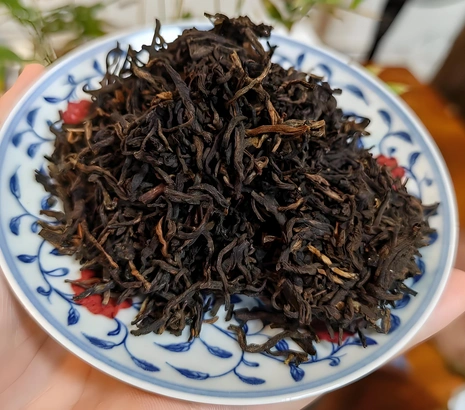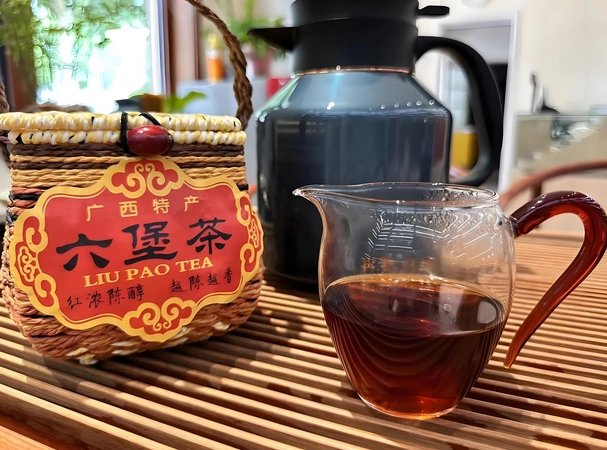Dark tea caffeine content greets you like a warm, comforting breeze after a long day—steady, nuanced, and quietly energizing. Imagine lifting a cup of deep, earthy brew to your lips, the heady aroma of damp forest floor and aged wood swirling up in delicate tendrils. As you inhale, notes of cocoa and woodsmoke tease your senses, promising a gentle lift rather than a sudden jolt. Unlike coffee’s sharp spike, dark tea offers a lingering clarity that carries you through late-night projects or busy mornings, all the while cloaking your spirit in calm.
This guide will unveil everything you need to know: how much caffeine resides in your favorite Pu-erh or Liubao cup, how processing and aging shape that content, and how to master your brew—whether you seek dark tea as coffee substitute or simply a smoother way to sustain your energy.
What Is Dark Tea and Why Does Caffeine Matter?
At its essence, dark tea is a post-fermented tea category steeped in centuries of Chinese tradition. After initial oxidation, tea leaves are piled, moistened, and left to ferment under controlled heat and humidity. This microbial alchemy yields the signature earthy, mellow flavor beloved by connoisseurs. Yet among its most intriguing aspects is how fermentation impacts dark tea caffeine content. Unlike fresh green or black teas, which derive their caffeine from leaf maturity and oxidation, dark tea undergoes a slow transformation: sugars and polyphenols break down, tannins soften, and caffeine’s release profile shifts. Understanding this content is crucial for anyone who relies on tea to spark creativity, fight post-lunch slumps, or replace morning coffee with a gentler ritual.

Factors Influencing Dark Tea Caffeine Content
Tea Variety & Origin
Not all dark teas carry identical caffeine levels. Classics like Pu-erh—especially raw (sheng) Pu-erh—often boast higher initial caffeine. In contrast, Liubao tea from Guangxi and Anhua dark tea in Hunan may present milder profiles. Variables include:
- Leaf Age: Younger buds (common in premium Pu-erh) concentrate more caffeine than mature leaves.
- Cultivar: Some tea plant varieties naturally contain more caffeine. Yunnan’s ancient tea trees, for instance, yield potent sheng Pu-erh.
Know your origin: a high-elevation Yunnan bud tea likely delivers more caffeine than a lowland Liubao blend.
Processing & Fermentation
The magic of dark tea lies in its post-oxidation microbial ballet. During “wet piling,” friendly molds and bacteria consume leaf sugars and polyphenols. This process:
- Reduces Bitterness and Astringency: As microbes transform polyphenols, the sharp bite softens.
- Modifies Caffeine Release: Though total caffeine remains, fermentation tweaks how quickly that caffeine infuses. A well-fermented ripe Pu-erh often yields caffeine more gradually, smoothing the sensory impact.
Thus, a carefully processed dark tea might feel less “jittery” than an equally caffeinated black tea.
Tea Age & Storage
Aged Dark Tea vs Fresh Dark Tea
- Fresh Pu-erh or early-stage Liubao carries robust polyphenols and slightly higher perceptible caffeine.
- Aged dark tea, in contrast, has mellowed tannins and a more nuanced caffeine release—its potency lingers gently rather than jolting.
Storing dark tea in dry, ventilated conditions allows subtle microbial activity to continue, rounding out flavor and softening caffeine’s edge. If you sip a 10-year-old Pu-erh, its caffeine may feel gentler than a freshly pressed cake.
Brewing Variables
Even after selecting a potent tea, your cup’s actual caffeine content hinges on how you brew:
- Leaf-to-Water Ratio: More leaves extract more caffeine. A standard 3g per 250ml yields moderate content; increase to 5g for a stronger lift.
- Water Temperature: Boiling water (95–100 °C) draws caffeine swiftly, while cooler temperatures (~85°C) slow extraction.
- Steep Time: Brief infusions (~30–45 seconds) yield lighter cups (30–40 mg caffeine), whereas longer steeps (3–5 minutes) approach 60–70 mg.
By adjusting these variables, you can tailor your tea’s kick—from a mild midday pick-me-up to a robust, focused brew.
Dark Tea Caffeine vs Coffee: A Comparative Look
Typical Caffeine in Dark Tea vs Brewed Coffee
A standard 8-ounce cup of dark tea falls in the 30–60 mg caffeine range, depending on tea type and brewing. By contrast, an equivalent serving of drip coffee often contains 95–165 mg. This disparity means:
- Dark Tea: A gentle, sustained lift—ideal when you crave focus without the racing heart.
- Coffee: A sharp spike in energy followed by a potential crash.
For many, dark tea as coffee substitute bridges the gap: you still enjoy a warm, aromatic ritual but sidestep the jitters and sudden energy plunge.
Benefits & Trade-Offs of Using Dark Tea as Coffee Substitute
Opting for dark tea over coffee:
- Pros:
- Lower Acidity: Easier on the stomach, particularly for those prone to acid reflux.
- Antioxidant Profile: Post-fermentation polyphenols (theaflavins, thearubigins) support cellular health.
- Gentle Neurological Lift: Caffeine plus theanine-like compounds promote alert calm.
- Cons:
- Milder Kick: Not as instantly energizing as espresso.
- Flavor Difference: Earthy, woody notes replace coffee’s roasted bitterness—an acquired preference.
If you’ve ever yearned for the ritual of a warm mug without caffeine overload, dark tea offers a nuanced, healthful alternative.

Health and Energy Benefits of Dark Tea Caffeine
Sustained Energy Without Jitters
Many black tea drinkers lament the midday crash. In contrast, dark tea caffeine unfolds gradually. A single cup can deliver:
- Steady Focus: Caffeine releases over 3–4 hours, smoothing energy levels.
- Calm Alertness: Fermentation yields L-theanine analogs—compounds that counterbalance caffeine’s stimulatory effects.
Swap your 3 pm coffee for a Ripe Pu-erh infusion and experience calm concentration instead of jittery nerves.
Antioxidants & Gut Support
Beyond stimulation, dark tea brims with healthful compounds:
- Post-Fermentation Polyphenols: Theaflavins help neutralize free radicals and support heart health.
- Probiotics & Enzymes: Ripe Pu-erh and Liubao contain beneficial microbes that foster gut health—hence the acclaim of dark tea for energy boost and broad wellness.
Regularly sipping a well-fermented dark tea can promote balanced digestion, smoother metabolism, and a more resilient microbiome.
When to Choose Dark Tea for a Gentle Lift
Consider dark tea when you need:
- Midday Sustenance: A dependable 40-60 mg caffeine that awakens without anxiety.
- Post-Workout Rejuvenation: Antioxidants that combat exercise-induced oxidative stress.
- Evening Clarity: Select a light-fermented Liubao to ease tension without disrupting sleep.
The next time you crave coffee’s promise but dread its crash, reach for a calming cup of dark tea.
Brewing Guide to Control Dark Tea Caffeine Content
Ideal Water Temperatures for Higher vs Lower Caffeine
- Higher Caffeine:
- Water Temp: 95–100 °C (203–212 °F)
- Steep Time: 3–5 minutes
- Leaf Ratio: 5g per 250ml
- Lower Caffeine:
- Water Temp: 85–90 °C (185–194 °F)
- Steep Time: 1–2 minutes
- Leaf Ratio: 3g per 250ml
Steep Times: Short Steeps vs Long Steeps
- Short Steeps (30–60 seconds): Yield a lighter infusion (≈30 mg caffeine), perfect for repeated infusions.
- Long Steeps (3–5 minutes): Draw more caffeine (up to 70 mg), suitable for mornings or when you need extra strength.
Multiple Infusions and Caffeine Draw
High-quality dark teas, especially raw Pu-erh and Liubao, can handle 6–8 infusions. Note:
- First 2–3 Infusions: Highest caffeine concentration; rich, bold structure.
- Later Infusions: Caffeine gradually declines, unveiling nuanced flavors—sweet honeyed notes, aged malt, or forest floor.
By sipping each infusion, you tailor both aroma and caffeine levels to your preferences.
🔗 To learn more about how to make tea, check out Tbiwencha’s YouTube video explaining how to make tea.
Incorporating Dark Tea as Coffee Substitute in Daily Life
Morning Routines: Switching from Coffee to Dark Tea
Swap your daily latte with a strong Ripe Pu-erh or dark Liubao. Prepare your teapot the night before:
- Preheat: Rinse teapot with hot water.
- Measure: 5g tea leaves for a robust wake-up cup.
- Infuse: Pour boiling water (95–100 °C) and steep 4 minutes.
Feel the restoration as dark tea’s gentle caffeine release banishes fogginess without the acid reflux you feared.
Office and Study Scenarios: Steady Focus with Dark Tea
When deadlines loom, reach for dark tea for energy boost:
- Keep a small travel infuser at your desk.
- Use 3g leaves in 200ml water; steep 2 minutes for a moderate lift (≈30 mg caffeine).
- Sip slowly while reading, coding, or brainstorming; the resultant focus is subtler, yet longer-lasting than coffee’s quick spike.
You’ll find fewer afternoon crashes, smoother concentration, and a calm drive through tasks.
After-Meal Rituals: Digestion Benefits
After rich lunches, choose dark tea after oily meals to soothe:
- Brew a medium-dark Pu-erh or Liubao with 3g leaves in 250ml water at 90–95 °C for 3 minutes.
- The post-fermentation compounds help emulsify fats and promote bile flow.
- Experience comfort as heaviness melts away, leaving you revived for afternoon activities.
This ancient practice—tea with meals—now meets modern health understanding, affirming dark tea’s digestive prowess.

Selecting & Storing Quality Dark Tea
Identifying High-Caffeine vs Low-Caffeine Dark Teas
- High-Caffeine: Look for raw Pu-erh cakes, young leaf Liubao, or unaged Anhua tea—higher leaf maturity and less oxidation preserve caffeine.
- Low-Caffeine: Seek well-aged Pu-erh (>5 years) or Liubao stored in dry conditions; extended aging breaks down caffeine and tannins, giving smoother cups.
Proper Storage to Preserve Caffeine Stability
- Airtight, Opaque Containers: Shield against moisture, light, and odors.
- Cool, Dry Environment: Maintain 15–25 °C; humidity 60–70% for raw Pu-erh.
- Separate by Type: Store raw Pu-erh and Liubao in ventilated spaces to allow continued slow fermentation. Keep ripe Pu-erh sealed to avoid over-fermentation.
When properly stored, dark tea can age for decades, naturally refining both flavor and caffeine profile.
FAQs About Dark Tea Caffeine Content
Q: How much caffeine is in a typical cup of dark tea?
A: An 8-ounce (240ml) cup of dark tea brewed for 3 minutes typically contains 40–60 mg of caffeine, depending on leaf type, age, and steeping variables.
Q: Can dark tea fully replace my morning coffee?
A: Yes—dark tea as coffee substitute offers a smoother lift, fewer stomach issues, and sustained focus. If you prefer a gentler onset and a calmer mind, switch to a morning Ripe Pu-erh or Liubao ritual.
Q: Does aged dark tea have less caffeine than fresh?
A: Generally, yes. Over years of dry storage, microbial activity and chemical transformations reduce quantifiable caffeine, making older teas ideal for evening enjoyment without disrupting sleep.
Conclusion: Mastering Your Dark Tea Caffeine Intake
Understanding dark tea caffeine content empowers you to tailor each cup to your needs—whether you crave an invigorating start, a stable midday focus, or a soothing post-meal remedy. By selecting the right tea variety, adjusting brewing parameters, and embracing ancient rituals, you can replace coffee with a mindful, healthful alternative. Explore dark tea as coffee substitute, compare dark tea caffeine vs coffee, and discover how minor tweaks—water temperature, steep time, leaf ratio—transform your experience. May each cup charm your senses, uplift your spirit, and guide you toward balanced energy and profound well-being. Cheers to your next enlightening infusion.



